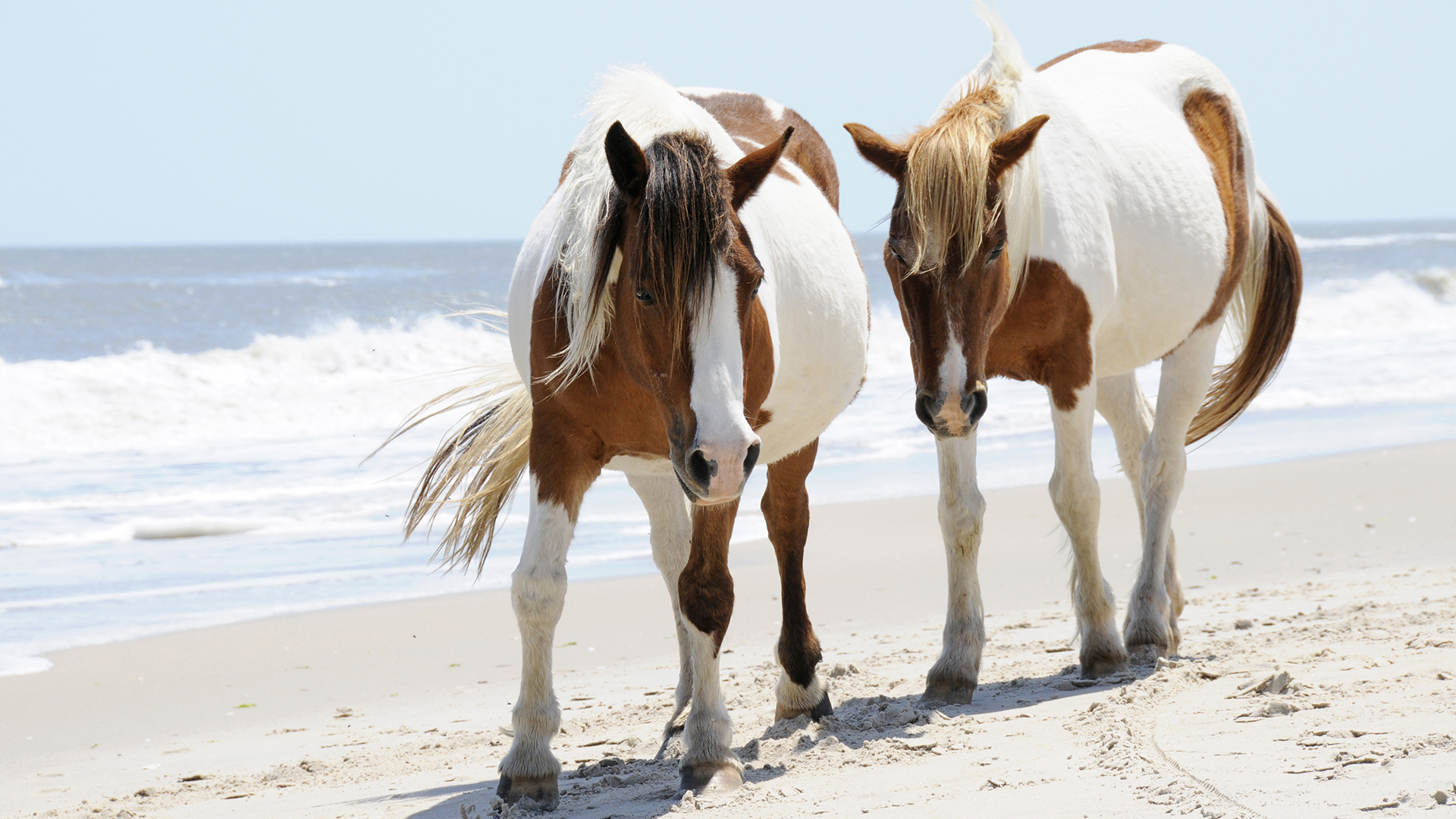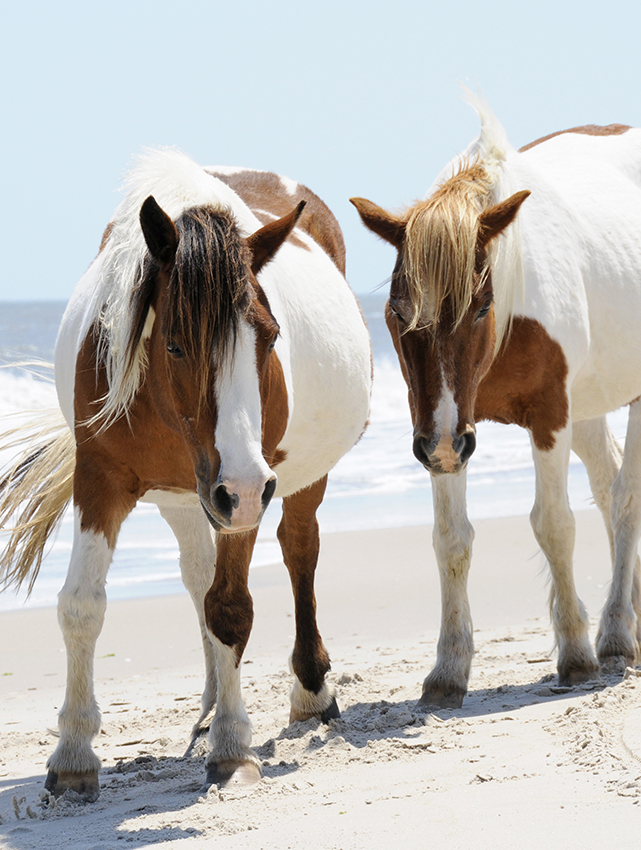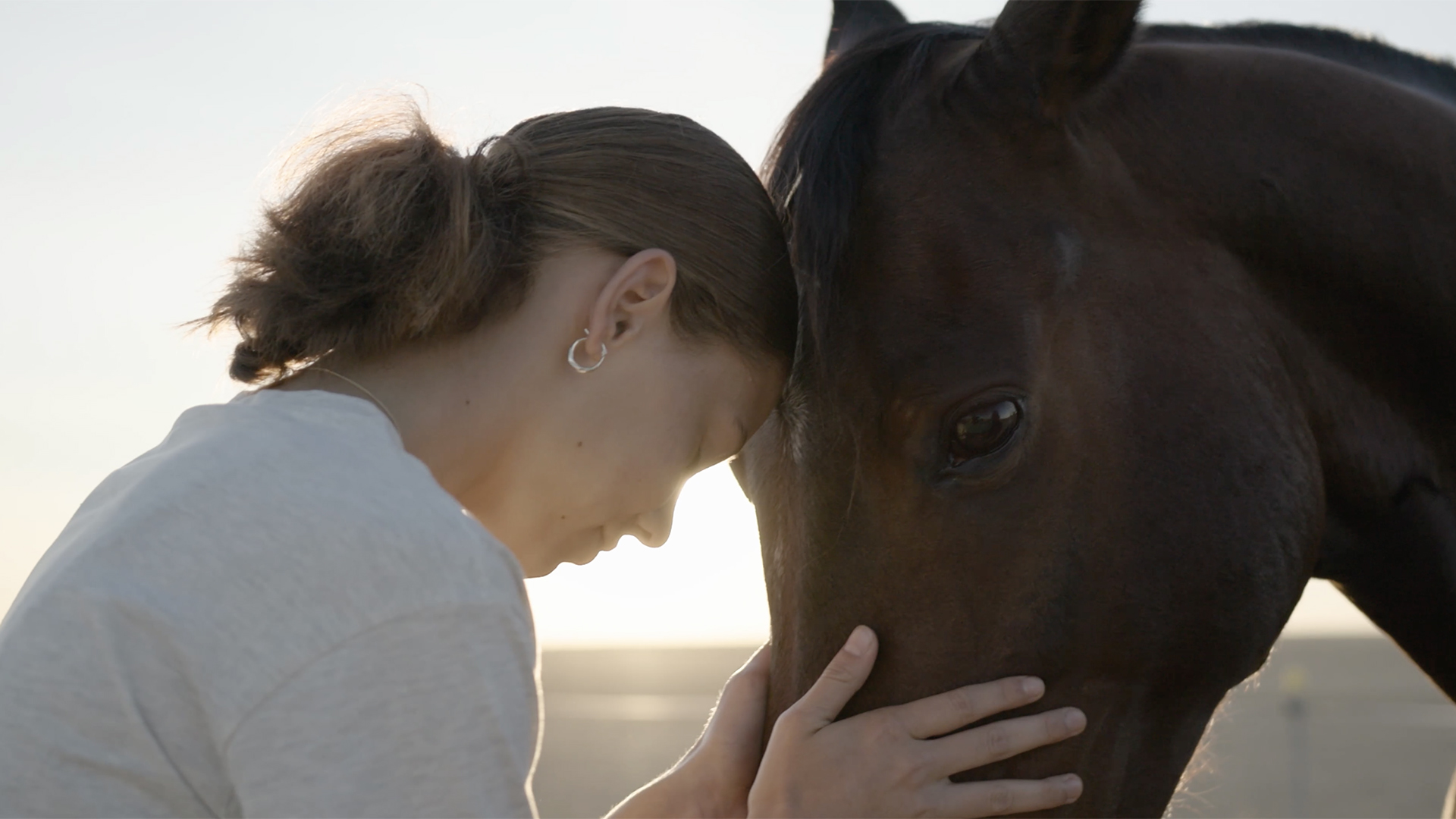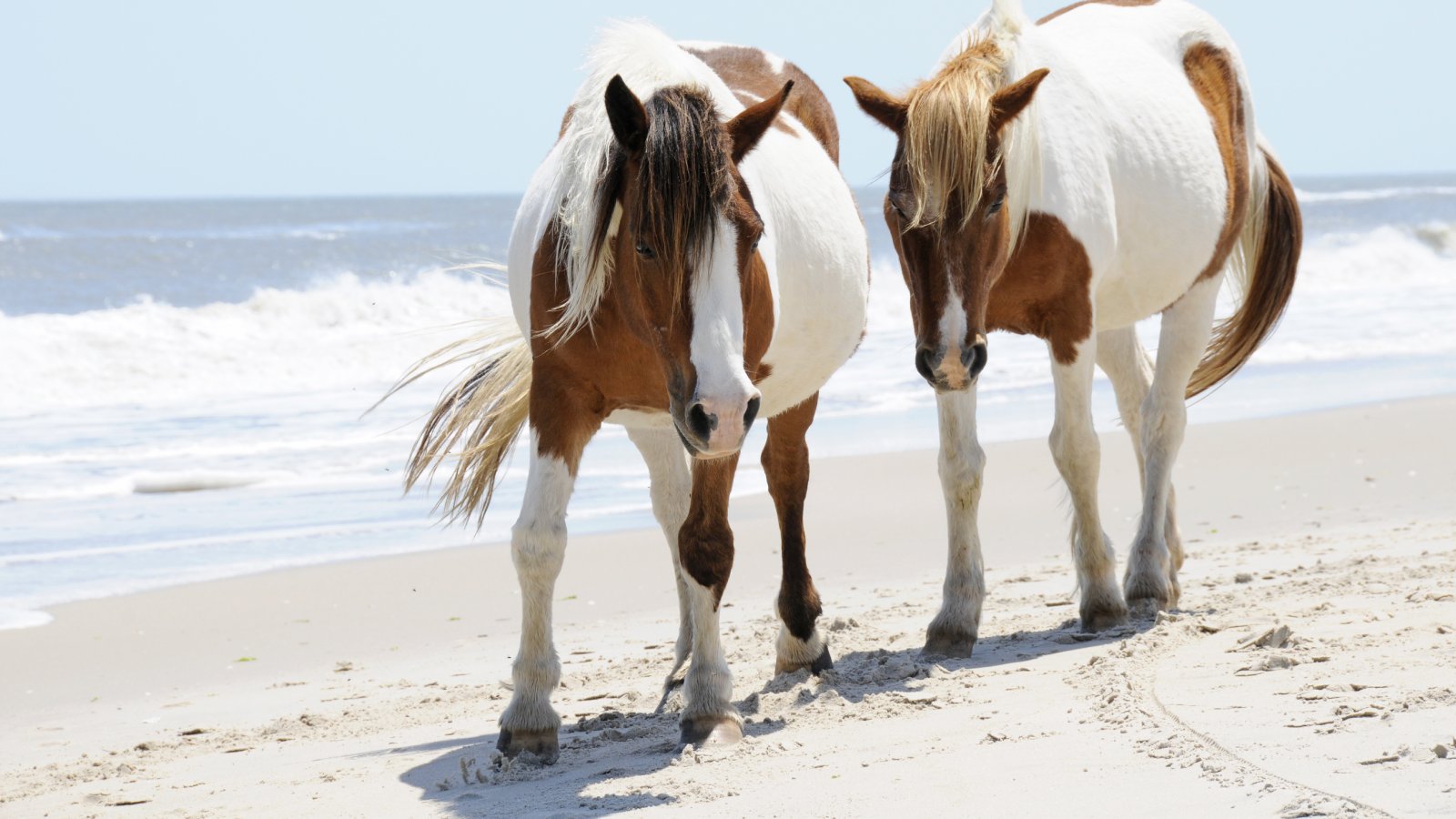The iconic Mustang is the USA’s pin-up horse and the first image that comes to mind when you think of wild horses in North America – however, there is another population of wild horses that have a long and colourful history.
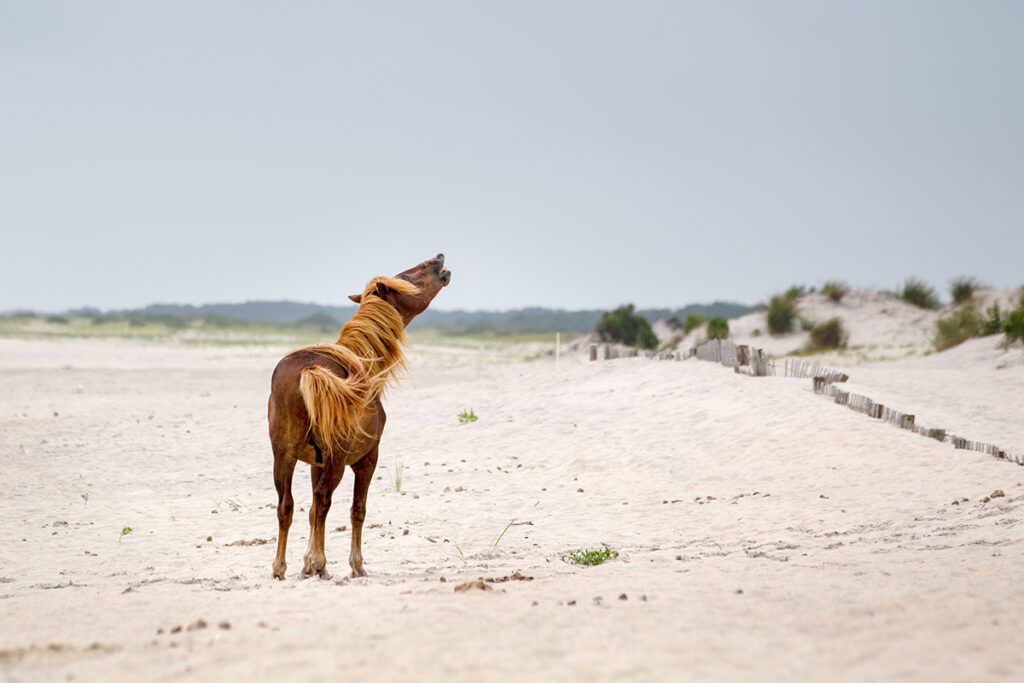
A stallion wanders along the beach on Assateague Island.
Isolated island life isn’t for everyone, but for a small population of wild horses on the east coast of the USA, it’s the only life they’ve known. Living on an island off the coast of Virginia and Maryland, the wild ponies of Chincoteague captured the imagination of horse-mad children around the world in 1947 when author Marguerite Henry published the acclaimed “Misty of Chincoteague”, the story of an elusive wild mare and her foal.
The origin of these sturdy little ponies varies depending on who you ask and ranges between fanciful tales of shipwrecks and pirates, to a slightly less glamorous colonial tax evasion scheme.
“The origin of these sturdy
little ponies varies…”
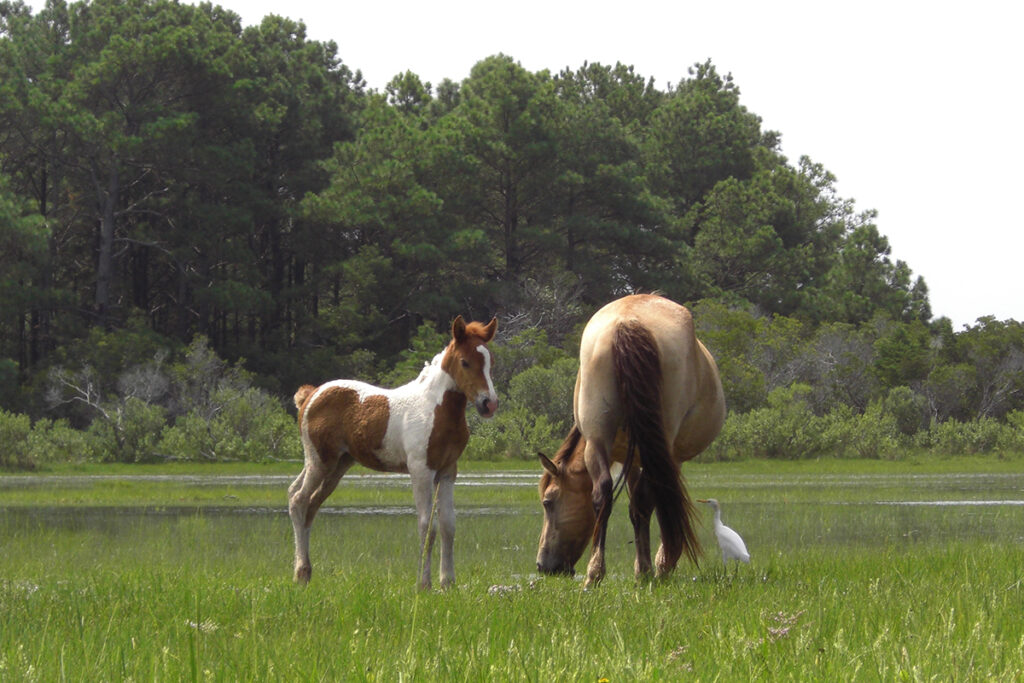
The ponies rely on freshwater ponds.
The most popular legend – and the one readers of Marguerite Henry’s book will remember – is that the ponies are descended from survivors of Spanish shipwrecks who swam ashore to Assateague Island in the 16th century (although they are referred to as Chincoteague ponies, they actually live on the larger island that lies next to Chincoteague Island). Others say they were left on the island by pirates. The more likely story – albeit a little less exciting – is that they descended from stock released by 17th century colonial settlers looking to escape livestock laws and taxes on the mainland.
The story goes that these ponies ran free largely uninterrupted by humans, surviving on a diet of cordgrass, a coarse grass that grows in salt marshes, as well as various other plants that grow on the island. It wasn’t until about 1835 when humans intervened; locals began rounding up some of the ponies and bringing them back to the mainland. “Pony penning”, as it became known, continued in different formats over the years, however, when in 1922 two fires ravaged Chincoteague, the Chincoteague Volunteer Fire Company was formed and the ponies subsequently took on a fund-raising role.
In 1924, the first official Pony Penning Day was held by the Chincoteague Volunteer Fire Company and ponies were auctioned off to raise money for fire equipment. This annual event has run almost every year since and continues in this format today, over a century later.
Held on the last consecutive Wednesday and Thursday in July, part of the spectacle involves the ponies swimming the Assateague Channel to the populated Chincoteague Island. The “Salt Water Cowboys” round up the ponies, drive them down the beach and then swim them across the channel at slack tide to Veteran’s Memorial Park. Once on Chincoteague Island, the cowboys herd the ponies to pens on the Carnival Grounds where suitable foals are auctioned off. Typically, 40,000 to 50,000 spectators come and watch each year. The swim takes five to 10 minutes, with the riders and observers on hand to assist horses, especially foals. Before the swim, the herd is evaluated at a vet check and horses that may have trouble swimming – for example, mares in the late stages of pregnancy and those with very young foals – are removed from the herd.
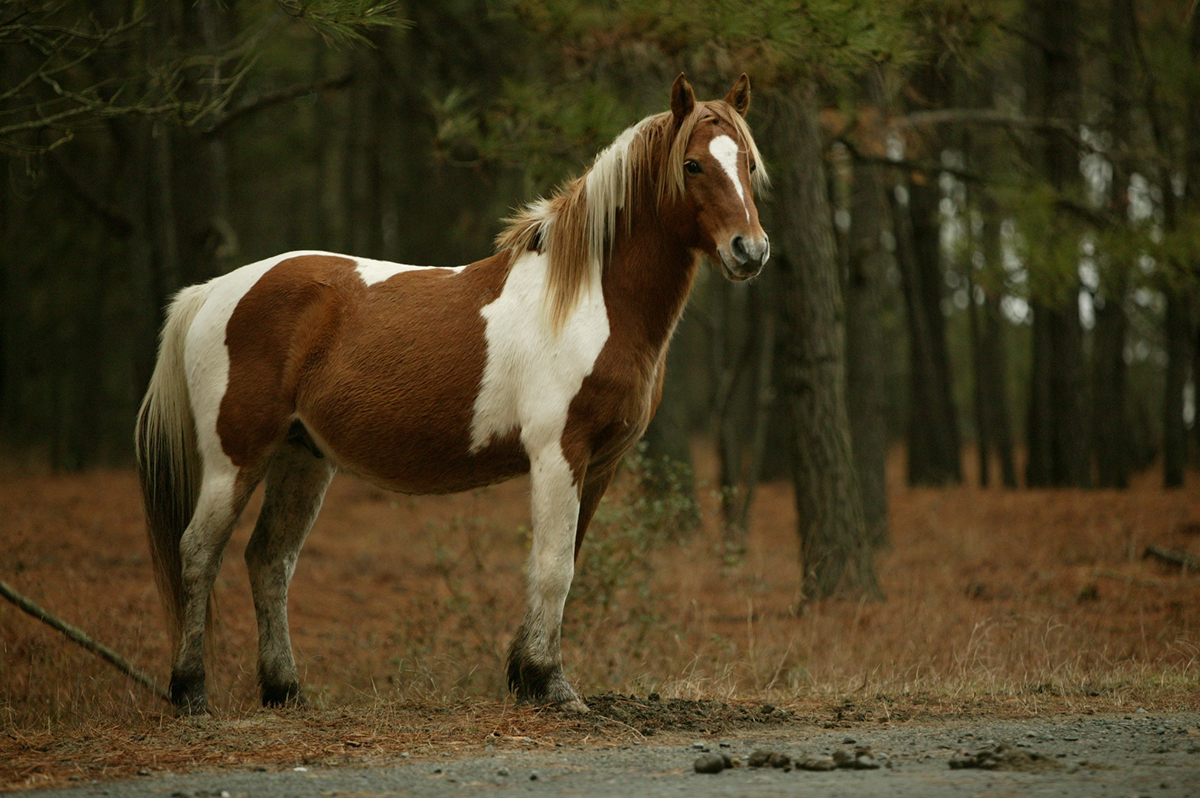
Pinto is a common colour amongst ponies on the island.
NEW BLOOD
Island life has presented problems over the years, particularly in terms of gene pool diversity. During the 1920s, conformation faults began to emerge due to inbreeding; to address this, Welsh and Shetland pony blood was added, and horses with pinto colouring were introduced to add colour and give the breed a more horse-like phenotype. This pinto colouring is documented in Henry’s book, with Misty herself being a pinto, and it is now synonymous with the breed. In 1939, 20 Mustangs were released, and not long after Arabian blood was added in the hope of refining their looks and increasing their height.
In 1943, Assateague Island was purchased by the federal government and divided into two protected areas, Assateague Island National Seashore in Maryland and Chincoteague National Wildlife Refuge in Virginia; today, the island remains split by a state border fence. Around 150 ponies live on either side of the fence, and are managed by two different federal agencies with two different management strategies.
The Virginia herd, referred to as Chincoteague ponies, is owned by the Chincoteague Volunteer Fire Company and lives within the Chincoteague National Wildlife Refuge. The Virginia ponies — which are the ones you will see if you attend the pony penning events — are treated to twice-yearly veterinary inspections, which prepare them for life among the general equine population if they are sold at auction. Some 30 to 45 foals are born into the Chincoteague herd each year, and the annual pony pennings are used to maintain the herd size at around 150 animals. Each year the Fire Company designates a select few ponies as “buy backs”; these foals are designated to return to Assateague Island to live out their lives, with the idea being to replenish the herd. The winning bidder of these ponies is allowed to choose a name before they are returned to Assateague. Historically, buy back ponies have actually fetched some of the highest prices at auction, with some going for as much as $25,000.
Conversely, ponies from the Maryland herd are managed by the National Park Service and are actually referred to as Assateague horses (rather than Chincoteague ponies) despite sharing the same origin. They are generally treated as wild animals, and are given no more or less assistance than other species on the island, other than to be treated with contraceptives to prevent overpopulation. The Maryland herd are on a much smaller parcel of land, and the confinement means they have been relatively easy to study from a scientific point of view. Since the ’70s, scientists have used the herd to conduct studies on feral horse behaviour, social structure, ecology, remote contraceptive delivery and pregnancy testing, and the effects of human intervention on other wild animal populations. There are few other wildlife populations of any species worldwide that have been studied in as much detail over as long a period as the Maryland herd.
Between 1968 and 1997 numbers increased from 28 to 165, and overgrazing became an issue. To manage population numbers, long-term, non-hormonal contraceptives have been employed, proving 95 percent effective over a seven-year field trial. The contraceptive has also proven effective at improving the health and increasing the life expectancy of older mares through the removal of pregnancy and lactation-related stress. Today, older ponies over the age of 20 and some even over 25 are found. Each mare between two and four years old is given contraceptives, and treatment is then withdrawn until she produces a foal. Once she has produced enough foals to be well represented genetically within the herd, she is placed on a yearly treatment plan until her death. Today, there are around 150 horses in the Maryland herd.
Perhaps not surprisingly, the two different management groups subscribe to different theories of origin. The National Park Service takes the arguably more logical approach and believes the ponies originated from 17th century settlers, while the fire department and National Chincoteague Pony Association follow the “Misty of Chincoteague” narrative and prefer the story of the 16th century Spanish shipwreck.
While only around 300 ponies in total (both states) live on Assateague Island, around 1,000 more live off-island, having been purchased or bred by private breeders. The National Chincoteague Pony Association was founded in 1985, and the Chincoteague Pony Association in 1994. The latter is open only to horses purchased from the annual auction, while the former maintains a breed registry and studbook that registers all ponies, including those from private breeders.
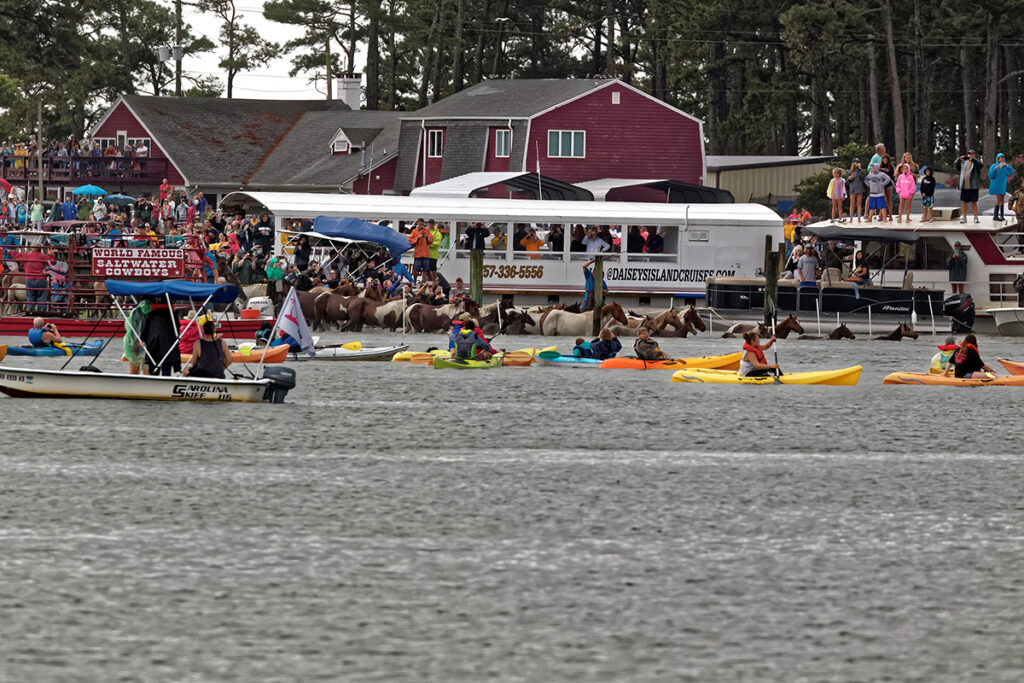
The annual pony swim draws thousands of spectators.
INTERNATIONAL FAME
When Marguerite Henry’s book was released in 1947 followed by a movie in 1961, the Chincoteague breed became internationally famous. Although the story was largely fictitious, there really was a pony by the name of Misty. She was foaled on Chincoteague Island in 1946, and was purchased as a weanling by Henry. The publicity generated by the story assisted the Chincoteague Fire Department and the breed in remaining viable into the 21st century. The Misty of Chincoteague Foundation was established in 1990 to preserve the Beebe Ranch, which features in the story, and to establish a museum with memorabilia from the series. Today, there are still a number of surviving descendants of Misty.
Unfortunately, life for these ponies hasn’t been purely island paradise. A few years ago, the Virginian herd fell foul to a rare fungus-like infection dubbed “swamp cancer”, and despite various medications, surgeries and round-the-clock care, Chincoteague ponies Essie, Rain Dancer, Lyra, Shadow, Lightning, Calceti’n and Elusive Star were tragically unable to battle the disease.
“Swamp cancer” is caused by Pythiosis insidiosum, an organism that can be found on dead grass in standing or stagnant water and typically survives when winter temperatures aren’t cold enough to kill the fungus. Horses are often infected when they stand in water with open cuts or sores, however, they can also drink, eat or inhale the dangerous spores. Once the fungus is in a horse’s body, it compromises the animal’s immune system and starts triggering granular, seed-like lesions, often on the lower legs and abdomen. Although it can infect dogs, cats and even people, it’s most common in horses and normally found in areas along the US Gulf Coast.
The disease sometimes can be treated with a therapeutic (not preventative) “vaccine,” immunotherapy and surgery. Treatment success rates are high if the disease is caught early, however, managing it in a semi-wild population of horses presents obvious challenges. Local veterinarians helped fire company volunteers treat the sick Chincoteague ponies and though treatments were working initially, it sadly came back with a vengeance. Those who have worked on the front line say the key to dealing with this devastating illness is prevention, rather than treatment; a preventative vaccine is being developed, but it’s yet to be approved by the U.S. Department of Agriculture. Fortunately, there are now no further signs of the disease and the rest of the herd are now healthy.
MEET THE WILD PONIES
Whether you’re a childhood fan of Marguerite Henry’s series or simply a horse lover wanting to see these ponies for yourself, the annual pony penning takes place at the end of July. Held on Chincoteague Island – Virginia’s only resort island – it is within easy reach from all major cities on the mid-Atlantic seaboard. This year marks 100 years of the annual pony swim, with the swim on 30 July and the auction on 31 July. If you’re heading to the US, why not check out these amazing ponies for yourself!
Find out more about the Chincoteague Island Pony Swim and auction here.
This article first appeared in the November/December 2019 issue of Equestrian Life. EQ
